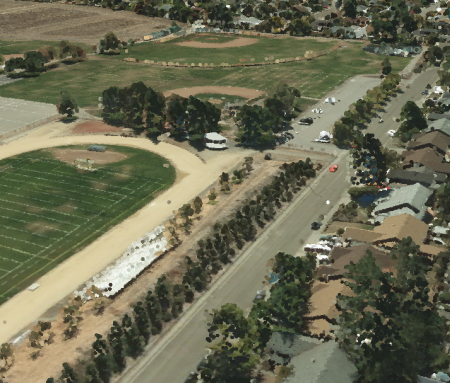The LAS dataset layer is available in ArcGIS Pro in either a 2D or 3D view. The LAS dataset stores references to one or more LAS files on disk, Optimized LAS (zLAS) and LAZ files, as well as to additional surface features. Optimized LAS (zLAS) and LAZ files are compressed versions of LAS files. The LAS dataset allows you to examine this data in its native format, providing detailed statistics and area coverage of the lidar data contained in the LAS files. You can quickly change the view of the LAS dataset into a TIN-based surface model. Also, the LAS dataset allows you to work with points classified into different feature types. You can add and use a LAS dataset that was created in previous versions of ArcGIS Desktop in ArcGIS Pro.
ArcGIS Pro is context driven, which means that the options available to you are dependent on the type of data you have selected in the Contents pane. When you select a LAS dataset in the Contents pane, you see a LAS Dataset Layer tab set containing a Data tab and a Classification tab. The functionality on these tabs contains options that are only relevant to the LAS dataset layer. When multiple LAS datasets are selected, a limited set of functionality is available. Display and analysis functionality can only be conducted on one LAS dataset layer at a time in ArcGIS Pro.
From the LAS Dataset Layer tab set, you have access to the basic functionality you need to alter the display and LAS filter options of the LAS dataset. For more information about this tab, see Change the symbology of a LAS dataset, Change filter options for a LAS dataset, and Point thinning and scalability of a LAS dataset.
Use the Data tab to complete many of the data management and analysis tasks associated with working with LAS datasets. To learn more about the functionality available on the Data tab, see Edit the data contributing to a LAS dataset.
Use the Classification tab to edit the classification codes associated with a LAS dataset. To learn more about the functionality available on the Classification tab, see Edit LAS file classification codes.
The ability to produce statistical information for LAS files referenced by the LAS dataset is essential to better understand the lidar data you are working with. When statistics are calculated, a LAS auxiliary file (.lasx) is created for each LAS file. It stores the calculated statistical information and the spatial index for each LAS file. See LAS dataset statistics for more information about understanding LAS dataset statistics in ArcGIS Pro.
Individual .las or .zlas files can be used in ArcGIS Pro with the same support as a LAS dataset layer. Individual .laz files can't be used in ArcGIS Pro with the same support as a LAS dataset layer.
A LAS dataset can also store references to feature classes containing surface constraints. Surface constraints are breaklines, water polygons, area boundaries, and any other type of surface feature enforced in the LAS dataset. Surface constraints are stored in feature classes, which are usually derived from some sort of remote sensing technique such as photogrammetry.
When a LAS dataset, .las file or .zlas file is added to a 3D scene in ArcGIS Pro, the points are drawn with an elevation renderer and eye-dome lighting applied by default. Eye-dome lighting is a shading technique that improves the perception of depth and contour when viewing LAS datasets. To turn eye-dome lighting on or off, select a LAS dataset in the Contents pane, select the LAS Dataset Layer tab set, and locate the Lighting and Shading group. Click the Eye-Dome Lighting button to turn the shading effect on or off. You can switch the shape in which points from a point cloud are being rendered from circles to squares to improve overall performance in a 3D scene.

Add a LAS dataset to a map or scene
When you open a new project in ArcGIS Pro, you must load a new map or scene. From the Insert tab, click New Map. There are a few ways to add a LAS dataset to the new map view. You can either connect to a folder or use the Add Data button.
When a LAS dataset or .las or .zlas file is added to a 2D map or 3D scene in ArcGIS Pro, the points are drawn with an elevation renderer.
Note:
A prompt will appear when a LAS dataset is added to a map or a scene that does not have a pyramid built; this prompt will request that you build a LAS dataset pyramid.
Folder connection
Having a folding connection set up in the Catalog pane provides quick access to your lidar data. To connect to a folder where the LAS dataset resides, click Add Folder on the Insert tab. The Add Folder Connection dialog box appears, allowing you to browse to the folder you want to connect to. Click the folder and click OK. Next, click the View tab and click the Catalog button to open the Catalog pane. To load the LAS dataset onto a map or scene, browse to your folder in the Catalog pane, and drag it into the map or scene view.
Add Data button
On the Map tab, click the Add Data button. On the Add Data dialog box, browse to the LAS dataset and click Open. The LAS dataset opens in the map or scene view.